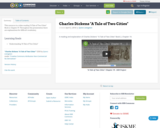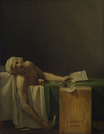
This resource is a video reading "A Tale of Two Cities" Book 2, Chapter 19. Throughout the presentation there are explanations for difficult vocabulary.
- Subject:
- English Language Arts
- Material Type:
- Interactive
- Date Added:
- 04/02/2018

This resource is a video reading "A Tale of Two Cities" Book 2, Chapter 19. Throughout the presentation there are explanations for difficult vocabulary.

The 11th grade learning experience consists of 7 mostly month-long units aligned to the Common Core State Standards, with available course material for teachers and students easily accessible online. Over the course of the year there is a steady progression in text complexity levels, sophistication of writing tasks, speaking and listening activities, and increased opportunities for independent and collaborative work. Rubrics and student models accompany many writing assignments.Throughout the 11th grade year, in addition to the Common Read texts that the whole class reads together, students each select an Independent Reading book and engage with peers in group Book Talks. Students move from learning the class rituals and routines and genre features of argument writing in Unit 11.1 to learning about narrative and informational genres in Unit 11.2: The American Short Story. Teacher resources provide additional materials to support each unit.

This unit uses William Shakespeare’s Much Ado About Nothing as a vehicle to help students consider how a person is powerless in the face of rumor and how reputations can alter lives, both for good and for ill. They will consider comedy and what makes us laugh. They will see how the standards of beauty and societal views toward women have changed since the Elizabethan Age and reflect on reasons for those changes. As students consider the play, they will write on the passages that inspire and plague them and on topics relating to one of the themes in the play. Finally, they will bring Shakespeare’s words to life in individual performances and in group scene presentations.
ACCOMPLISHMENTS
Students read Shakespeare’s Much Ado About Nothing .
Students read two Shakespearean sonnets and excerpts from an Elizabethan morality handbook dealing with types of women, and they respond to them from several different perspectives.
For each work of literature, students do some writing. They learn to write a sonnet; create a Prompt Book; complete a Dialectical Journal; and write an analytical essay about a topic relating to a theme in the play.
Students see Shakespeare’s play as it was intended to be seen: in a performance. They memorize 15 or more lines from the play and perform them for the class. Students take part in a short scene as either a director or an actor.
GUIDING QUESTIONS
These questions are a guide to stimulate thinking, discussion, and writing on the themes and ideas in the unit. For complete and thoughtful answers and for meaningful discussions, students must use evidence based on careful reading of the texts.
What are society’s expectations with regard to gender roles?
Does humor transcend time? Do we share the same sense of humor as our ancestors?
How do we judge people?
How important is reputation?
BENCHMARK ASSESSMENT (Cold Read)
During this unit, on a day of your choosing, we recommend you administer a Cold Read to assess students’ reading comprehension. For this assessment, students read a text they have never seen before and then respond to multiple-choice and constructed-response questions. The assessment is not included in this course materials.
CLASSROOM FILMS
The Branagh version of Much Ado About Nothing is available on DVD through Netflix and for streaming through Amazon. Other versions are also available on both sites.

In this lesson, you will administer a Benchmark Assessment (Cold Write) to determine what students already know about argument writing. Students will respond to a prompt, and then you will assess each student’s argument, using the scoring guide, as a measure of early work. Students will have opportunities to write arguments throughout the year, during which they will have instruction on how to revise and edit their pieces. The information you gain from scoring this benchmark piece of writing will guide you in tailoring your writing instruction to individual student needs.

In this lesson, students will see the Prompt Books as finished performances and reflect on what they’ve learned from Shakespeare during this unit.

In this lesson, students will continue to see what actually goes into a performance as they prepare to stage their Prompt Book scene.

People often say that mankind should learn from history. Charles Dickens, whose books are considered classics, set his novel A Tale of Two Cities in the past. He wanted his readers to learn from the bloody French Revolution and from the widespread brutality in London. Both cities (Paris and London) offer the reader a glimpse into dark and dangerous times. As students read about Dickens's Victorian setting and learn his view of the French Revolution, they will think about what makes a just world. Students will have a chance to think about their own experiences, and, using techniques they have learned from Charles Dickens, they will do some writing that sends a message about your own world.
ACCOMPLISHMENTS
To complete the unit accomplishments, students will:
Read the Charles Dickens novel A Tale of Two Cities.
Read several short pieces, including a biography of Dickens and excerpts from other literature, to help them understand Dickens’s world and the world of the novel.
Explore new vocabulary to build their ability to write and speak using academic language.
Practice close reading and participate in several role plays and dramatic readings to help them experience the dramatic writing style of Charles Dickens.
Write a vignette and a short narrative piece, and practice using descriptive detail and precise language.
Write a reflection about the meaning of Dickens’s novel.
GUIDING QUESTIONS
These questions are a guide to stimulate thinking, discussion, and writing on the themes and ideas in the unit. For complete and thoughtful answers and for meaningful discussions, students must use evidence based on careful reading of the texts.
How does good storytelling affect the reader, and how can a good story promote change in the world?
What was the Victorian view of gender roles?
How can power be abused?
What is loyalty ? What are the limits of loyalty?

In this lesson, you will consider the relationship between character and caricature, and discuss the ways that Dickens presents his characters—whether realistically or as exaggerations—and begin to explore the reasons he might have had for presenting his characters in this way.In this lesson, students will consider the relationship between character and caricature, discuss the ways that Dickens presents his characters— whether realistically or as exaggerations—and begin to explore the reasons he might have had for presenting his characters in this way.

In this lesson, students will review dramatic irony and verbal irony and learn how Dickens is using different kinds of irony to make the readers feel suspense, fear, and horror.

In this lesson, students will consider the ways that Dickens continues to build suspense for his readers and discuss one of the central questions of the novel: What is loyalty?

In this lesson, you will have a chance to involve yourselves in the dramatic language of Dickens by performing parts of the text.In this lesson, students will have a chance to involve themselves in the dramatic language of Dickens by performing parts of the text.

In this lesson, students will explore the ways in which Dickens reveals his moral values through his characters.

In this lesson, students will explore the ways that Dickens points his readers at meaning through symbolism, and they will consider Dickens’s opinion of the Revolution.

This course investigates the uses and boundaries of fiction in a range of novels and narrative styles, traditional and innovative, western and non-western, and raises questions about the pleasures and meanings of verbal texts in different cultures, times, and forms.

Serial Storytelling examines the ways the passing and unfolding of time structures narratives in a range of media. From Rembrandt’s lifetime of self-portraits to The Wire, Charles Dickens’ Pickwick Papers to contemporary journalism and reportage, we will focus on the relationships between popular culture and art, the problems of evaluation and audience, and the ways these works function within their social context.

Have you ever had such a hard time understanding what the book, "The Tale Of Two Cities?" I know I have, so I ended up making an animation that helps you understand what book 2, chapter 14 is talking about. In this chapter, you will find that there are a couple of characters, Cruncher, Cruncher Jr., Town Folks, Roger Cly, and much more. Cruncher Jr learned that his father sold dead bodies to earn income.

In A Tale of Two Cities, Charles Dickens foreshadows the events of the French Revolution throughout his novel. He uses symbolism to convey the dark future that the French Revolution will bring. This resource provides a detailed literary analysis on A Tale of Two Cities. In this video, we will go over the foreshadowing found in the 5th chapter.